
The triangle piercing is a modern innovation, first performed in the early 1990s. The piercer who invented it left the industry shortly thereafter, and I took over perfecting and popularizing this amazing, functional piercing.
The triangle is a horizontal piercing just underneath (not through!) the shaft of the clitoris, at the base of the hood. The stimulation from this piercing comes from added sensation behind your clitoris. This is quite unlike the other genital piercings, such as the popular VCH, which contacts the clitoris from the front.
General Information
The triangle is a very advanced piercing because it is placed largely by feel in an area where unfortunate and unacceptable damage could be done if a mishap occurs. Scrutinize the qualifications of any piercer who is under consideration to perform your triangle. Find out exactly where and how they learned to do this particular piercing and how many they have done. If you aren’t thoroughly impressed with a piercer's training and experience, keep looking. I frequently see terribly botched "triangle" piercings. Some images are below.
The triangle is one of my specialties (surely I've done more of them than any other piercer on the planet) and it is one of my favorite piercings to perform.
Many people ask whether a Vertical Clitoral Hood (VCH) or a triangle is the most stimulating piercing, but the truth is that they are completely different. Lots of piercees get one of each. If you are built for and interested in both, the VCH is an excellent introduction to genital piercing because it is fast and easy to heal as well as rewarding. The triangle is sometimes described as a more intense piercing, and it does have a longer healing time, so previous experience with genital piercing is helpful but in no way mandatory. Wearing both a VCH and a triangle creates a titillating sandwich: your sensitive clitoris is surrounded by jewelry, front and back.
I have had more than one client confide that they'd never (ever) had an orgasm in their entire twenty-plus years, until after I performed their triangle piercings! Since the partners and sexual activities were the same as pre-piercing, the triangle piercing obviously made all the difference. Knowing that triangle piercings I've performed have cured primary anorgasmia more than once totally validates my life’s work. No piercer can make promises, but if you're anatomically suited, and interested in the piercing, it is certainly worth a try!
Want to get pierced by Elayne Angel?
Placement
Optimal anatomy has a number of vital requirements for safety and success--all of which must be met for you to be a viable candidate:
• You need to have a protruding hood in the shape that I call a "hill," and it must be relatively symmetrical and of sufficient height. If your anatomy in that area is very narrow, small, or flat; or if you have a "valley" shape, in which your hood is concave, then you are not a candidate for this piercing. Some vulvas are built with a hill that is located within a valley. That is, the hood is large enough, and in a suitable configuration, but it is recessed within full outer labia. This type of build may be pierceable, but is considerably more challenging procedurally, and having the appropriate jewelry style and fit is especially critical.
• Your piercer must be able to identify and pinch behind your clitoral shaft (the cordlike nerve bundle) at the base of your hood, to slightly lift it away from your body. If this structure cannot be located or lifted, or if it rests deeper than the natural base of the hood, it is not possible to safely do the triangle piercing. See this page with more information and a video to clarify the location.
However, being able to find and pinch behind the shaft does not automatically make one pierceable for a triangle. The other anatomical considerations weigh equally on suitability. If you go in for a triangle and your piercer doesn't look for this structure--get up and leave!
• The base of the hood, where the triangle piercing should be placed, must be clear of blood vessels. It is fairly common for veins to be located in this region. Sometimes they are mobile and can safely be moved out of the way. But if a visible vessel is in the piercing's path and cannot be avoided, the triangle must not be pursued.
• Additionally, the surrounding region must be configured in a way that helps to stabilize the jewelry and hold it in place. If all else is suited but this requirement left unfulfilled, there's a likelihood of healing problems from excessive jewelry movement and twisting.
• Finally, some people are otherwise suited to the piercing, but their inner lips divide so high up at the top of the vaginal opening that the piercing would end up through two separate pieces of tissue there. For more on this, read about the biangle piercing.
Simply put, most vulvas are not anatomically suited to the triangle piercing. I'm able to honor only about 25-30% of the requests I get for it.
This is the one of the most commonly misplaced--and often horribly botched--piercings I see. (The other is the Vertical Clitoral Hood (VCH) piercing.) I often see "triangles" that are too high, and not located beneath the clitoral shaft, meaning, in essence, that they're unintentional Horizontal Clitoral Hood (HCH) piercings. I also see "triangles" that are positioned too low, and therefore too far away from the clitoral shaft to be stimulating. Sometimes these end up as two separate piercings of upper inner labia that are joined with a single piece of jewelry. Other times, I see them too far forward, and away from the base of the hood. These have been known to result in very painful and potentially damaging accidental piercings of the clitoral glans. Other times they pierce the clitoral shaft, which is also extremely painful, and could result in damage. I've seen a host of other "creative" so-called triangle placements that were unnecessarily agonizing for the piercees, and resulted in no enjoyment whatsoever.
The properly placed triangle and HCH piercings both pass through the same type—and even a similar amount—of hood tissue. However, for most piercees the triangle is the far more pleasurable option.
I'm happy to do an online anatomy consultation to determine if you appear to be a candidate for a triangle piercing, even if you plan to go to another piercer. Go here to see the photos I'll need to do your anatomy consult.
Note that I ALWAYS wear gloves for client contact! Images without gloves were sent to me for consultations, and are posted anonymously and with permission.
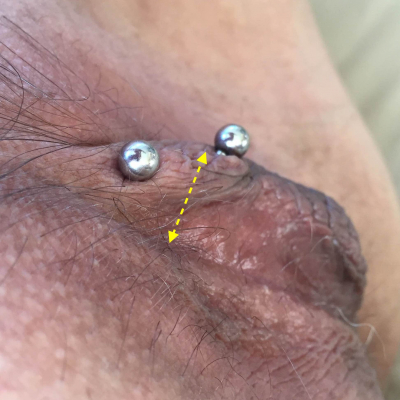
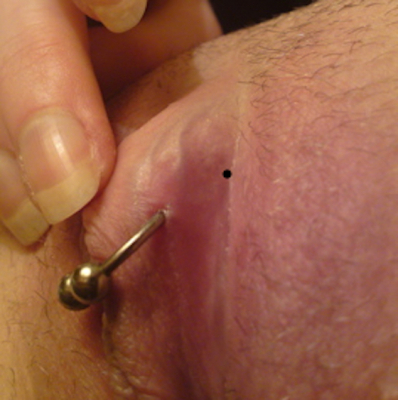
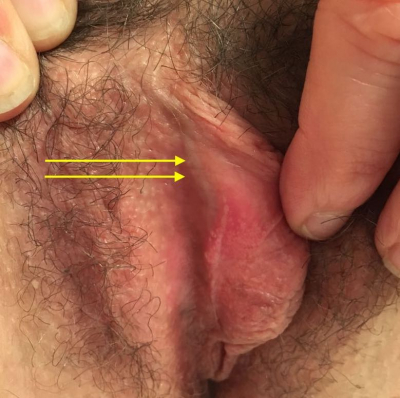
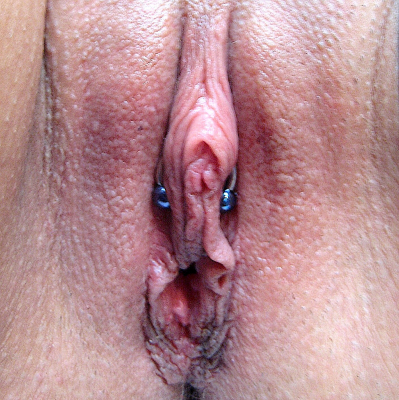

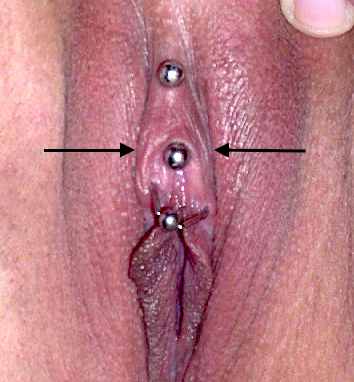
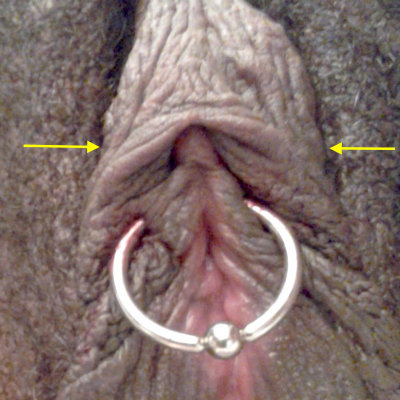
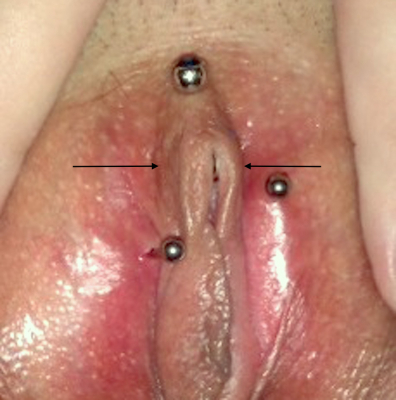
Jewelry
Due to the recessed location of the piercing and the vertical orientation of the vulva, the safest and most comfortable jewelry for a healing triangle piercing is a custom-fit opened circular barbell. The base jewelry should be a diameter or two smaller than you need to accommodate your tissue, then the gap between the balls is widened by spreading out the ring. This can be done very easily with ring expanding pliers.
It may be C-shaped or (almost) U-shaped, depending on your build. The portion of the ring that passes through your tissue is relatively straight, and fits in the limited space between your legs without twisting like circular ring-style jewelry, nor shifting like bar-style jewelry. The gap between the circular barbell balls must be wide enough to accommodate your tissue so the jewelry tucks down flat, to cradle the upper portion of your inner labia. The surrounding structures hold the jewelry securely in place. Also depending on build, it may be preferable to wear the jewelry flipped upward, rather than tucked down. Either direction is fine if it is comfortable and does not put pressure against the piercing.
After healing, you can try out a captive ring, bead ring, teardrop, D-ring, curved or straight barbell, or other jewelry style. Some wearers--especially those with tall hoods--often find that the open circular barbell is the only jewelry that feels truly comfortable.
Because the anatomy is manipulated (the clitoral shaft is lifted) to put in the piercing, removing the jewelry occasionally results in a total loss of your triangle, instantaneously. The channel can be very hard to locate immediately following jewelry removal. I suggest insertion tapers always be used for jewelry changes, to keep the channel occupied at all times.
The triangle is a sturdy piercing and, although not always easy to stretch, it can be expanded to hefty sizes with time and patience. Some piercees enjoy the way heavier or thicker jewelry looks and feels after enlarging a healed triangle to a larger gauge.
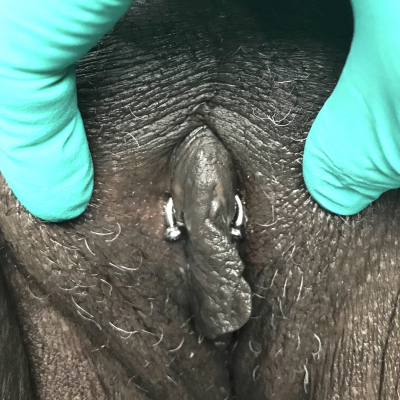


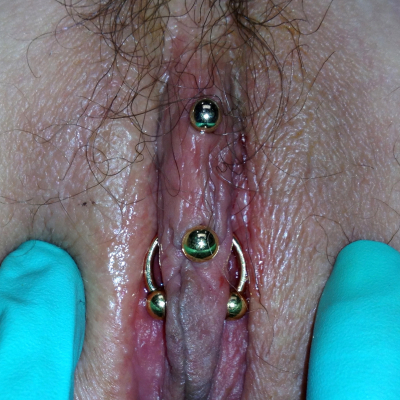

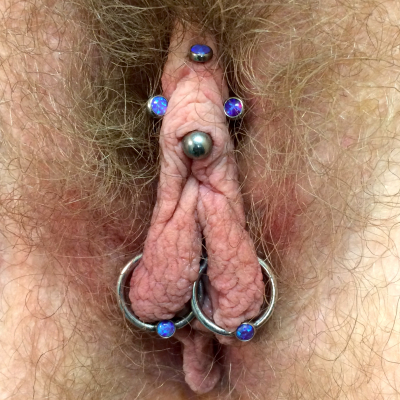
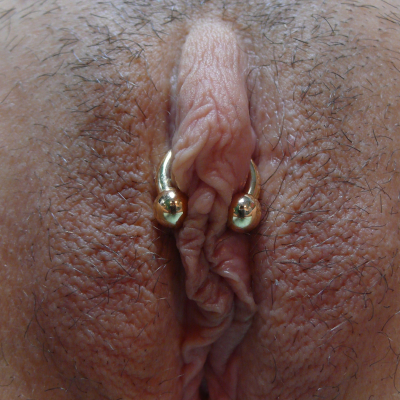
Procedure
I use forceps on triangle piercings. First I perform tissue manipulation with my fingertips to lift and isolate the clitoral shaft, and make a bit of extra space at the base of the hood for the head of the clamps. This is extremely helpful to assure correct placement, and it makes it safer and easier to apply the forceps.
It is crucial that a constant hold is maintained to keep your clitoral shaft elevated while the tool is applied and the piercing is performed. If the cordlike structure drops back down, the piercing will not be in the correct position. Your clitoral shaft itself might get pierced, or you will end up with a low or deep hood piercing, but not a triangle. If your piercer does not seem concerned with keeping your clitoral shaft lifted, they probably do not know where a triangle is supposed to be placed!
Some piercers use "septum forceps," which have a short piece of receiving tube attached to the ends, and this can be a successful way to perform the triangle piercing.
I’ve had piercees comment that the triangle was easier than a nipple or hood piercing; but others find the experience more intense and draining. Still, when skillfully executed, the piercing will be momentary.
Learn which piercing(s) you are built for?
Healing and Troubleshooting
The triangle is the vulva piercing most likely to be a heavy bleeder, so don’t be surprised if you spot, or even flow, for several days afterward. It is prudent to wear at least a panty liner, if not a pad, for several days.
If you have an asymmetrical build or your jewelry is too wide to rest evenly between your legs, migration is to be expected. It may move just a little and then stop and settle, or you may need to abandon the piercing. Wearing the proper jewelry type and size is imperative for healing. If your C-ring or U-ring does not comfortably tuck close to your body, the ring, ball, or gap size may need to be adjusted. If your piercing is not healing well and you are not wearing a custom-widened circular barbell, then you should have one inserted.
Note that even when perfectly placed on ideal anatomy with optimally sized and shaped jewelry, this piercing will sometimes migrate and end up crooked or angled. This is simply a risk of placing a horizontal piercing in a vertically-oriented part of the body.
Consider carefully a decision to remove triangle jewelry, even momentarily; reinserting it later is often impossible.
Because the piercing is located back against the body at the natural folds, evidence of an abandoned triangle is hardly visible.
What My Happy Clients Say
Almost 3 weeks in the healing process and I am already so in love with this piercing!
I’ve been able to feel & experience things after this piercing that I have never been able to feel - prior to this piercing, and the sensations are only intensifying as the healing process progresses! Thank you!
After about 3 weeks I thought that my triangle was completely healed because the added pleasure was fantastic and not at all painful. Since another month has passed, I find that I am even MORE pleased with my decision!!
I am so tempted to walk up to strangers on the street and tell them about the many benefits of the triangle and clitoral hood piercings! Thank you for using your God-given gifts to enhance the lives of women.
I cannot express how wonderful my piercing experience with Elayne was! She was so personable- professional and the best piercer and artist I have ever met!
I got a triangle and a VCH- all in gold and beautiful! The healing has been great- easy and I am out of my funk!
Thanks Elayne for making me feel HOT again ; )
